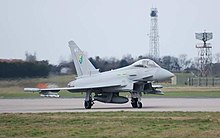RAF Coningsby
Royal Air Force Coningsby or RAF Coningsby (IATA: QCY, ICAO: EGXC), is a Royal Air Force (RAF) station located 13.7 kilometres (8.5 mi) south-west of Horncastle, and 15.8 kilometres (9.8 mi) north-west of Boston, in the East Lindsey district of Lincolnshire, England.
It is a Main Operating Base of the RAF and home to three front-line Eurofighter Typhoon FGR4 units, No.
Coningsby is also the home of the Battle of Britain Memorial Flight (BBMF) which operates a variety of historic RAF aircraft.
However progress in the compulsory purchase of the land was slow and delayed the start of work for two years.
Equipped with Avro Lancaster heavy bombers, the squadron was stationed at Coningsby from August 1943.
Due to its specialist nature, the Dambusters carried out limited operations whilst at Coningsby, with the most notable being Operation Garlic, a failed raid targeting the Dortmund-Ems canal in Germany, when five out of the eight Lancasters on the mission failed to return home.
As the squadron required more space, it moved to nearby RAF Woodhall Spa in January 1944, swapping places with another Lancaster unit, No.
3 Group, took off from the base in a Gloster Meteor, and crashed into a Dutch barn at Bradley, Staffordshire.
[10] From 1964 to 1966, the station had been initially designated to receive the proposed RAF strike aircraft, the advanced BAC TSR-2,[10] which was cancelled in April 1965 by the Labour Government.
The TSR2 had large development costs, whereas the F-111 (also known as Tactical Fighter Experimental, or TFX) could be bought off the shelf.
Coningsby was planned to get the F-111K, the RAF version of the F-111; also in the 1966 Defence White Paper, it was intended that the Anglo-French AFVG, later the UKVG, would replace the TSR2 (it did eventually as the Panavia Tornado).
HMS Eagle was never converted to Phantom use as it was deemed too expensive, and the carrier was scrapped in January 1972, with its Sea Vixen aircraft.
On 18 May 1970, a Phantom flew from the base non-stop to RAF Tengah in Singapore, covering 8,680 mi (13,970 km) in 14 hours and 14 minutes at an average speed of 602 mph (969 km/h).
11 Group in Strike Command, when the SEPECAT Jaguar (situated in Norfolk) took over the ground attack role.
Three Sector Operations Centres were at RAF Buchan, Boulmer and Neatishead; in the 1960s, the UK had the Linesman/Mediator radar system, which was obsolete by the 1970s.
[18] Tornado training took place until April 1987, when the Phantoms left (to RAF Leuchars) and Coningsby had the first (No.
[22] During the Gulf War, Tornados from Coningsby were based for three months at Dhahran International Airport to participate in Operation Granby.
6 Squadron relocated with their SEPECAT Jaguars to Coningsby on 1 April 2006, where it was planned they would operate from until October 2007.
[32] In October 2019, RAF Coningsby signed a twinning agreement with Fighter Wing 73 (Jagdgeschwader 73) of the German Air Force (Luftwaffe) to enhance opportunities to meet and train with one another.
[35] BAE Systems Military Air Solutions, who produce the Typhoon, are also stationed on the airfield with the contract to maintain the aircraft.
[37] William, Prince of Wales served as the station's Honorary Air Commandant from 2008 till 2023.
[40] The Eurofighter Typhoon FGR4 provides the RAF with a multi-role combat capability for air policing, peace support and high intensity conflict.
[41] Since June 2007, Coningsby's Typhoons have been responsible for maintaining the Quick Reaction Alert (Interceptor) South mission (QRA(I)S).
QRA missions range from civilian airliners which have stopped responding to air traffic control, to intercepting Russian aircraft such as the Tupolev Tu-95 Bear and Tu-160 Blackjack.
Formerly the Fast Jet and Weapons Operational Evaluation Unit (FJWOEU), which was formed by merging the Strike Attack OEU (previously based at MOD Boscombe Down) and the Tornado F3 OEU (now returned back to its home base of RAF Coningsby[43] after a temporary 'lay-over' at RAF Waddington) and the Air-Guided Weapons OEU (previously based at RAF Valley).
[44] Coningsby has been home of the Battle of Britain Memorial Flight (BBMF) and the associated visitor centre since March 1976 when it arrived from RAF Coltishall.
The ALI Cell moved to Coningsby from RAF Honington in Suffolk and came under the control off the wing in June 2018.
2 Group (Air Combat Support) Royal Engineers RAF Coningsby's badge, awarded in December 1958, features a depiction of Tattershall Castle.
[56] 1974 Norfolk mid-air collision: On 9 August 1974, the station commander 42-year-old Group Captain David Blucke, and his navigator Flight Lieutenant Terence Kirkland (aged 28 and from Derry), were killed whilst piloting the Phantom XV493 of 41 Squadron.
Flying at low level, it hit a Piper Pawnee crop-spraying plane (from Southend-on-Sea) over Fordham, Norfolk, near Downham Market.









